ABaC (Barcelona, Spain)
Àbac Restaurant
Av. del Tibidabo, 1, Sarrià-Sant Gervasi, 08022 Barcelona, Spain
+34 933 19 66 00
www.abacrestaurant.com
Sun 10/20/2024, 08:00p-11:20p

After visiting both Sagrada Família and Park Güell in an admittedly Gaudí-heavy day, I ended up making my way to the Sant Gervasi – la Bonanova neighborhood for dinner at the ABaC Hotel, a boutique property on the edge of the city, near Tibidabo hill. Helmed by Chef Jordi Cruz, the hotel's namesake restaurant is one that I'd known about for years, so I definitely wanted to check it out and see how it'd hold up.
About the Chef: Jordi Cruz Mas was born in June 1978 in the city of Manresa, Bages county, north of Barcelona proper. He knew early on that he wanted to become a chef, and eventually made his way to the Escola Hoteleria Joviat in his hometown. At age 14, he began working as a server at Estany Clar in Cercs, and took over the kitchen at age 17, earning his first Michelin star there in November 2004. Cruz continued to make a name for himself through winning various culinary competitions, and would leave Estany Clar in December 2007.
From there, he became head chef at L'Angle at Hotel Món Sant Benet in Sant Fruitós de Bages, near Manresa, opening the restaurant in April 2008 and achieving a Michelin star just months later, in November that year. In April 2010, he took the reins at ABaC, which bowed in 2000 (on Carrer del Rec in Ciutat Vella--it moved to its current spot in May 2008) under the watch of Xavier Pellicer, most known for his work at Can Fabes. Cruz restored the restaurant's two Michelin star rating in December 2011, while a third star arrived in November 2017.
Following, the Chef continued to grow his relationship with the ABaC Group. In June 2012, he launched Ten's Tapas Restaurant at the Park Hotel, situated in the original home of ABaC, while April 2013 saw him debut as a judge on the Spanish version of MasterChef. Angle moved to Hotel Cram in June 2013, and received its second Michelin star in November 2019, though it's since been demoted back to one. In September 2019, Cruz opened the bistro-ish Atempo, which received its own star from Michelin in December 2020.

Here we see the dining room, a serene, elegant, somewhat muted space.
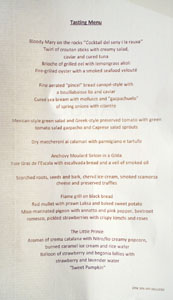
There's but a single tasting menu option at ABaC, priced at 295€ ($321.38) a head. The wine pairing costs an extra 140€ ($152.52), but as per usual, I opted for a bottle, and actually arrived early to pick out something from the restaurant's considerable wine list. Click for a larger version.
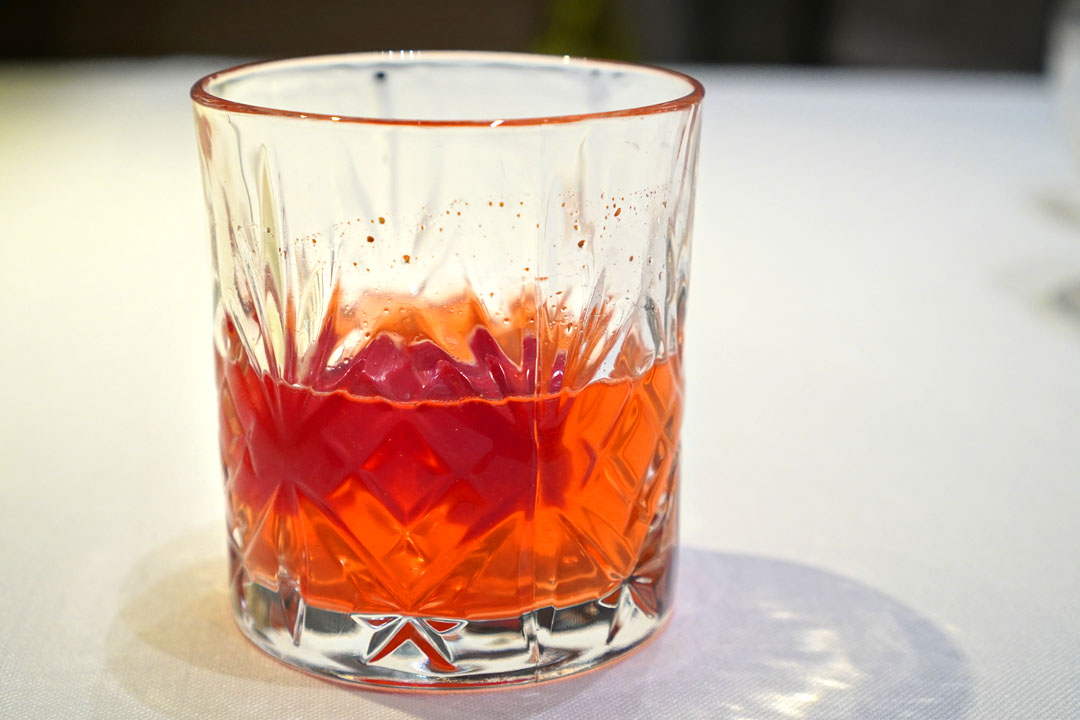
1: Bloody Mary on the rocks "Cocktail del seny i la rauxa"
The evening commenced with a welcome cocktail of sorts, one featuring clarified cherry tomato along with some sophisticated spicing, not to mention an ice cube composed of what I believe was beetroot and strawberry. It did a great job capturing the essence of the classic Bloody Mary, and was one of the best versions of the drink I've had.
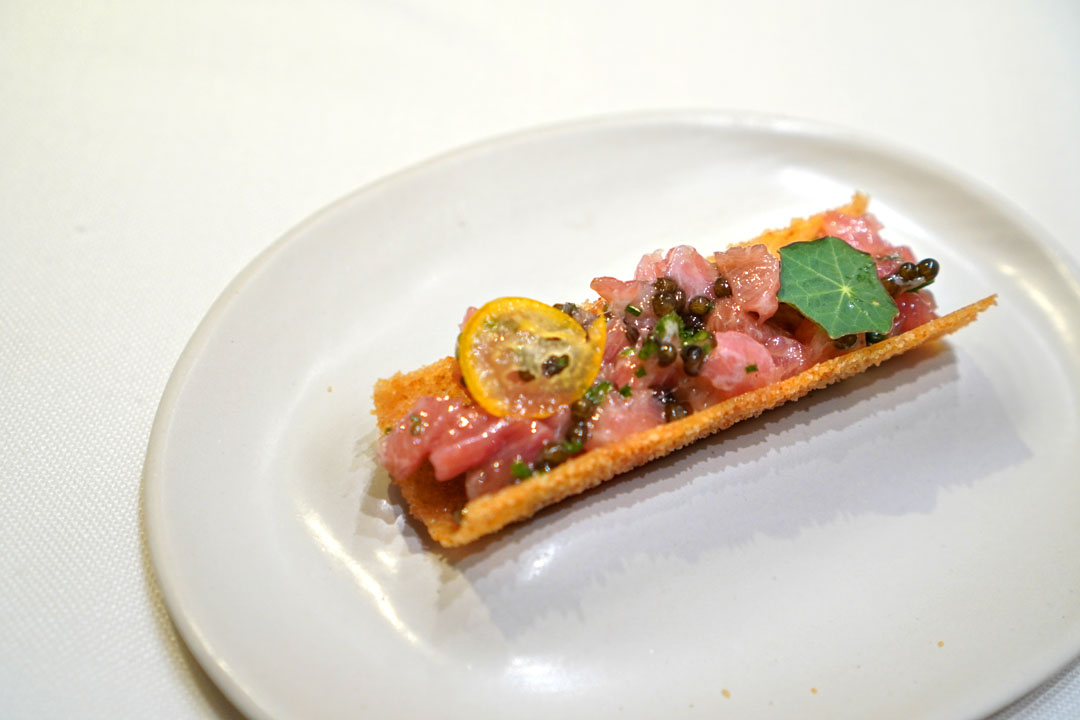
2: Twirl of crouton sticks with creamy salad, caviar and cured tuna
Sitting atop a sweet-n-savory, shattery crouton was a base of ricotta-mascarpone cheese sauce, a lush tuna belly tartare, caviar, chives, and a slice of kumquat. Taken all together, it made for this vaguely Asian-y sensation that I didn't mind.
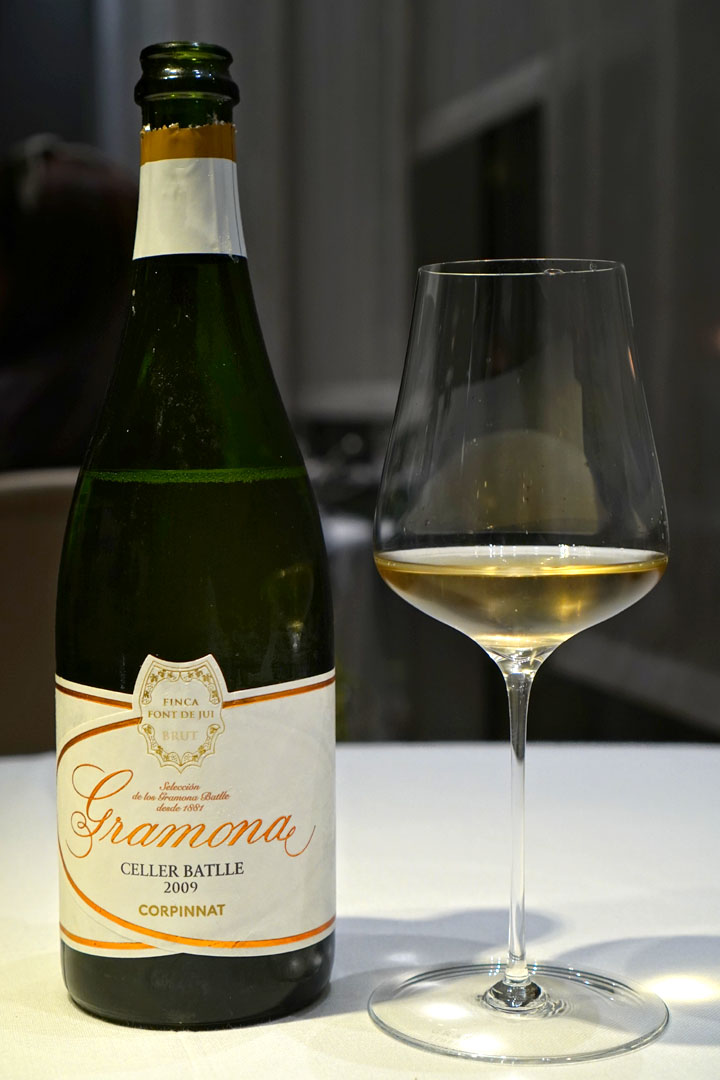
Not surprisingly, I chose something local and bubbly to drink, this time the Gramona Celler Batlle 2009 [169€ ($184.11)]. Initials aromas here were all about toffee and butterscotch, which led to flavors of both bright apple cider and darker, oxidized nuances. With some time, the sparkling wine went in a buttery, Burgundian direction on the nose, and further time brought a bouquet of sweet, juicy, tropical fruit, while the palate was still refreshing, vivacious, and citric this whole time. My final glass of the Corpinnat smelled somewhat earthier, and taste-wise, I found that the juice went in a more acidic, more bitter, boozier direction.
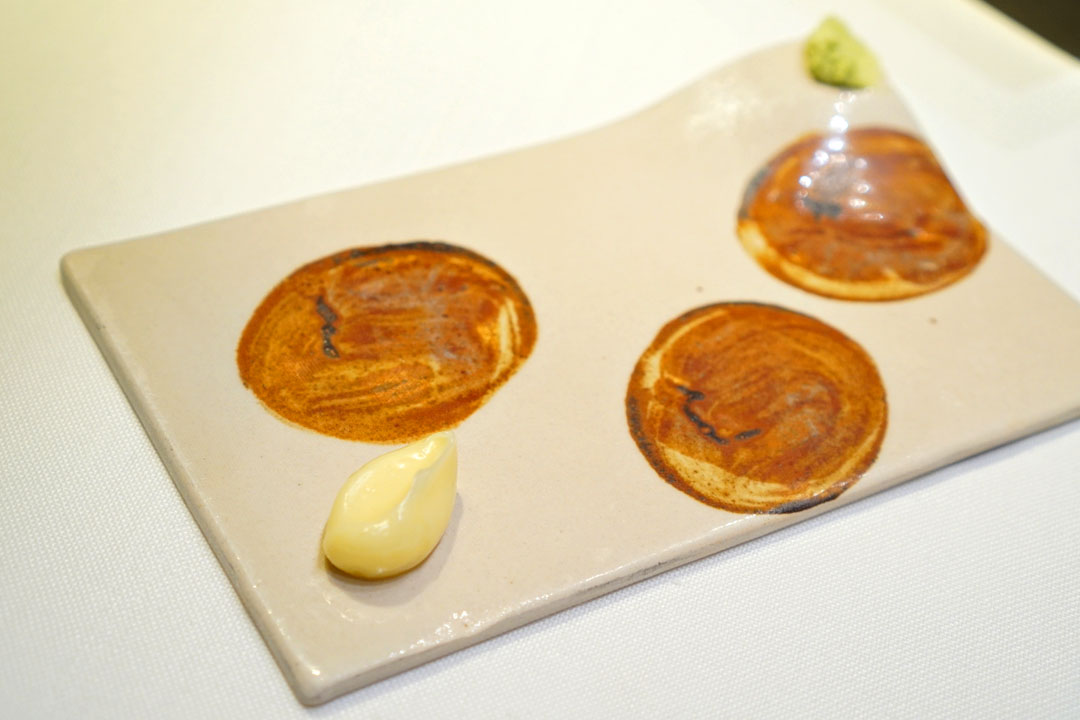
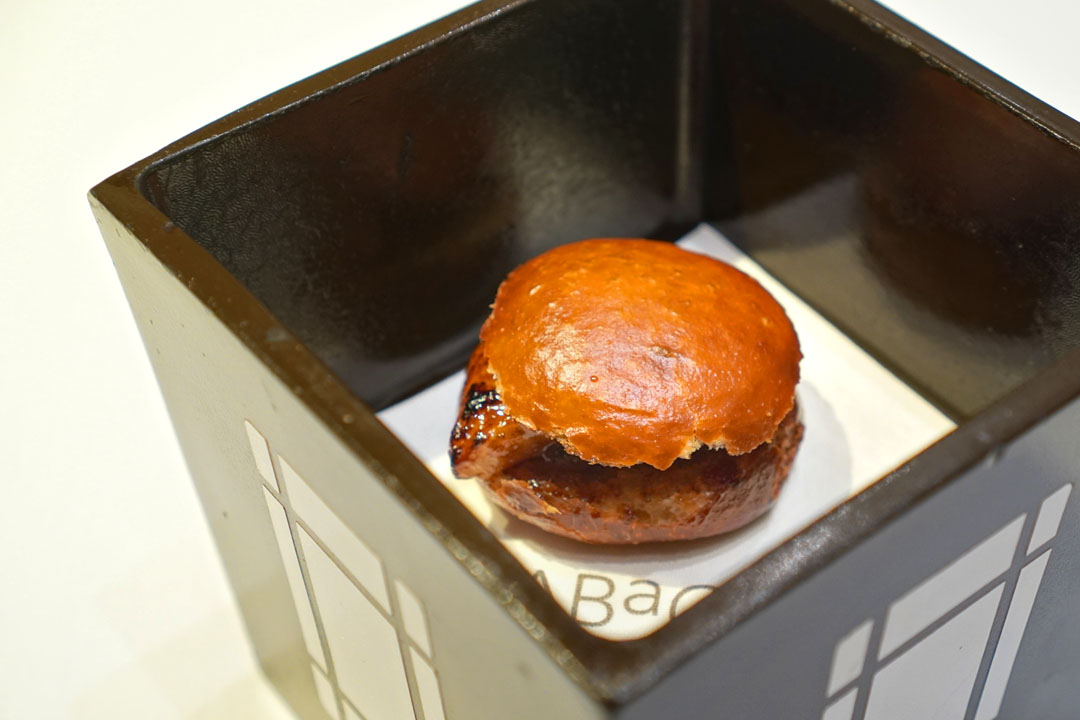
3: Brioche of grilled eel with lemongrass alioli
A Chinese-y French brioche was stuffed with tender, juicy grilled eel bathed in teriyaki sauce. Accompaniments included a lemongrass aioli, but I much preferred that freshly grated wasabi, which did an admirable job offsetting the sweetness of the bun.
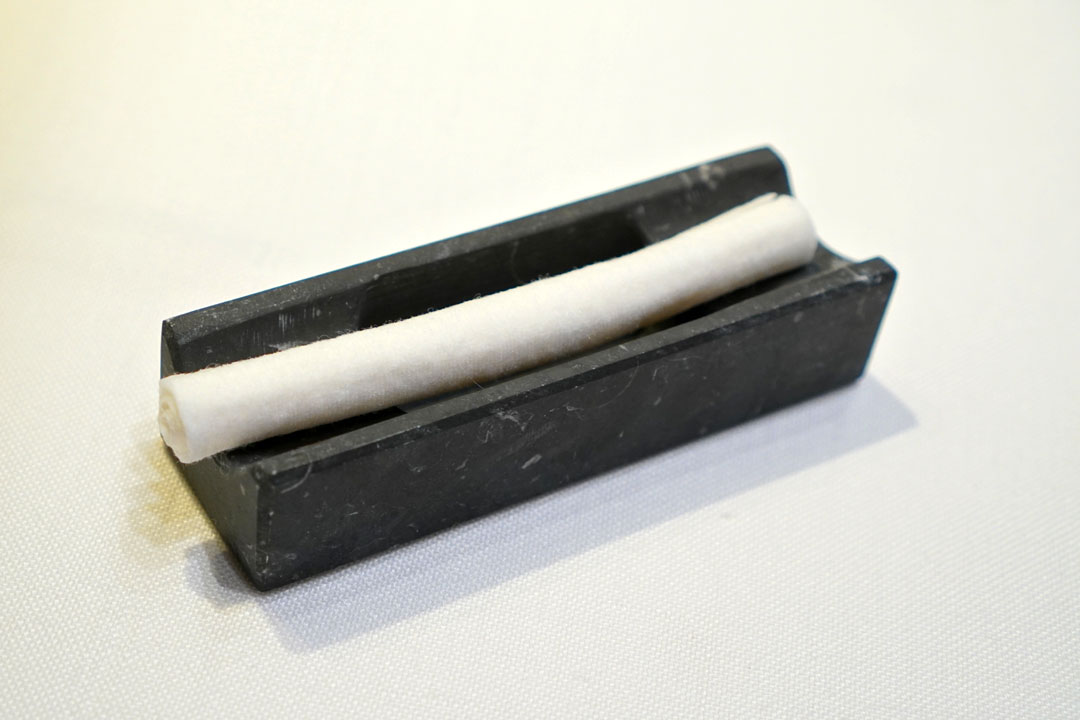
Given the finger food nature of the bites above, a tightly-rolled moistened napkin was provided at this point.
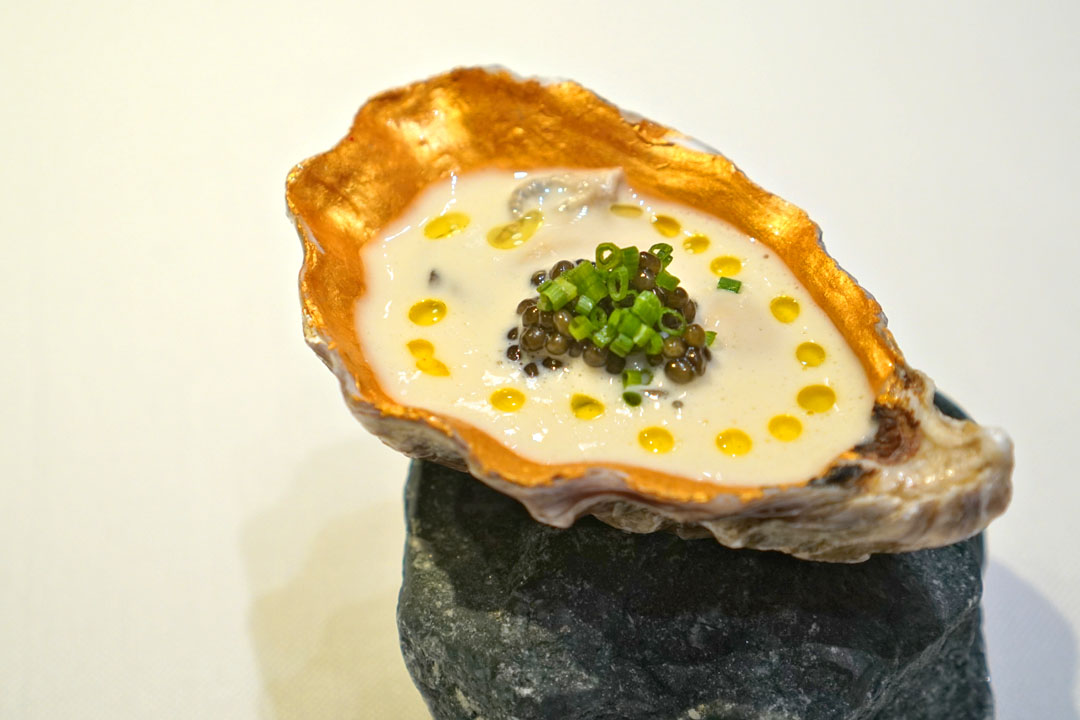
4: Fire-grilled oyster with a smoked seafood velouté
In the final canapé course, an oyster was grilled in its own shell, then placed in a gilded shell and joined by squid velouté, olive oil, chives, and caviar. The key here was the back-and-forth between the bivalve's long-lingering brine and the creaminess of the sauce, with further accentuation from both the caviar and tangy olive oil.
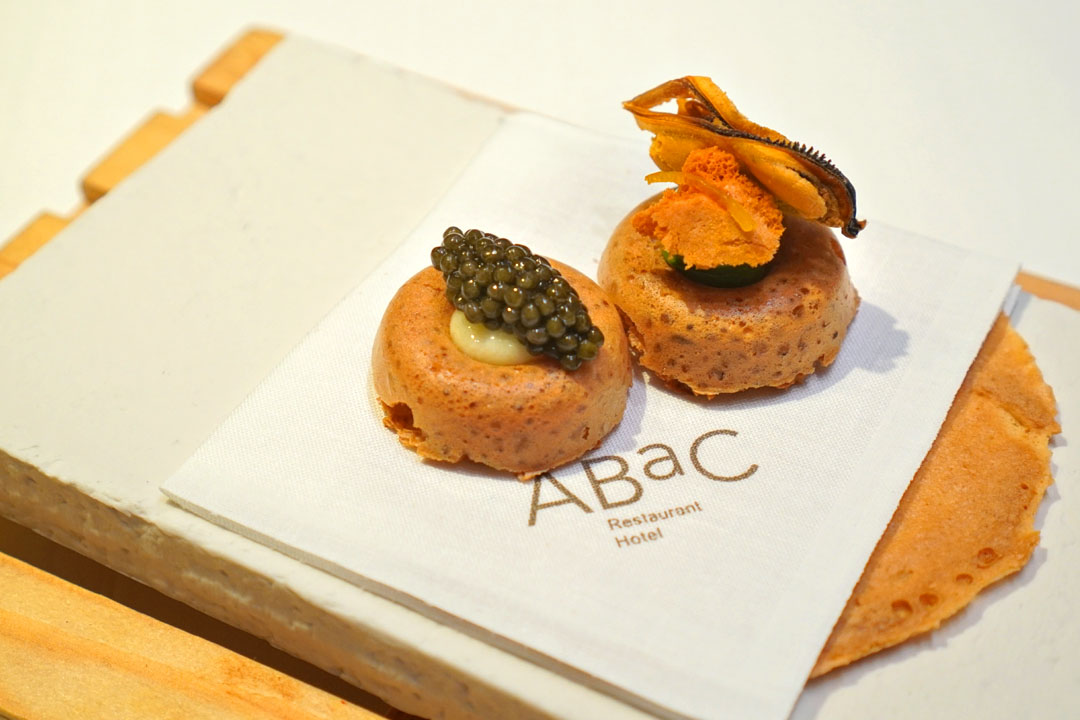
5: Fire aerated "pincel" bread canapé-style with a bouillabaisse lio and caviar
Taking inspiration from the idea of "bread and butter," my next course turned out to be a twofer. Two servings of aerated bread were presented, and I began with the one on the right, with its Breton butter base, freeze-dried mussel, and freeze-dried red prawn. The bite succinctly conveyed the character of a seafood stew, but I wasn't as keen on its super dry texture. I preferred my second bite, which combined caviar and French butter in expert fashion, with both elements nicely offset by the crunch of the "pincel." Also tucked into a napkin here was a delightfully thin bread meant to pair with the dish below.
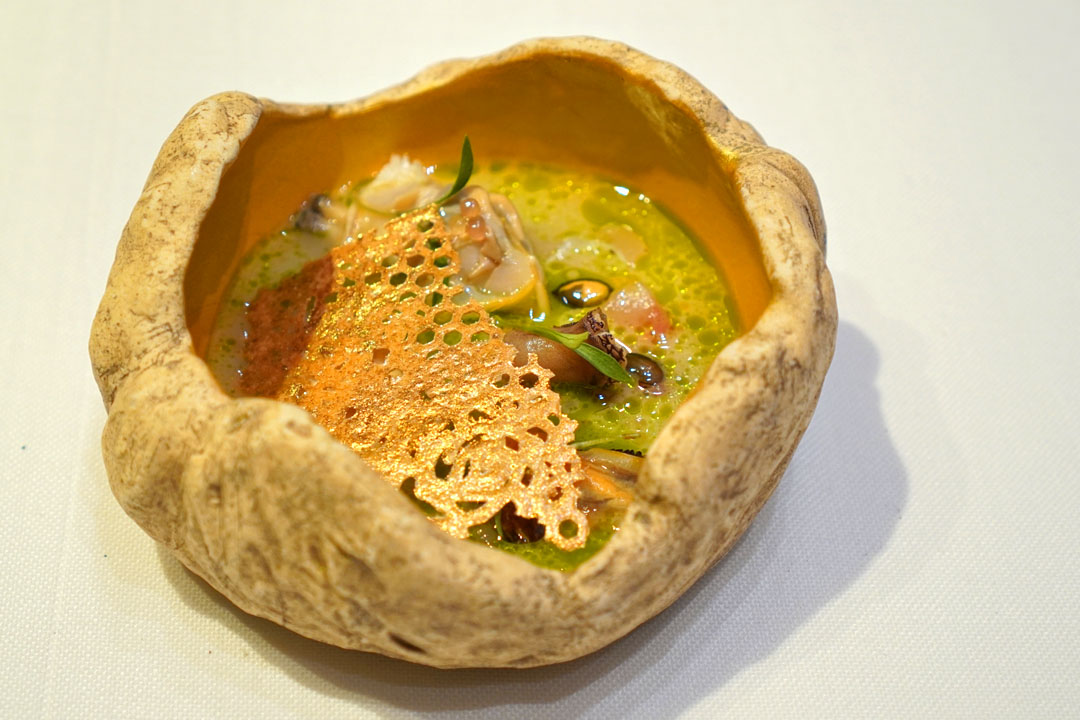
6: Cured sea bream and molluscs and "gazpachuelo" of spring onions with cilantro
This reimagined ceviche was a definite favorite of mine, really representing the spirit of the traditional dish. It was composed of clams, goose barnacles, mussels, cured seaweed, coriander oil, golden lattice bread, and chickpea hummus ice cream, all set in a zingy lime-onion marinade poured tableside. I loved the brightness and acidity present, and how that meshed with the assertive brine and textures of the seafood (the mussels in particular), all while the ice cream proffered a wonderful temperature contrast.
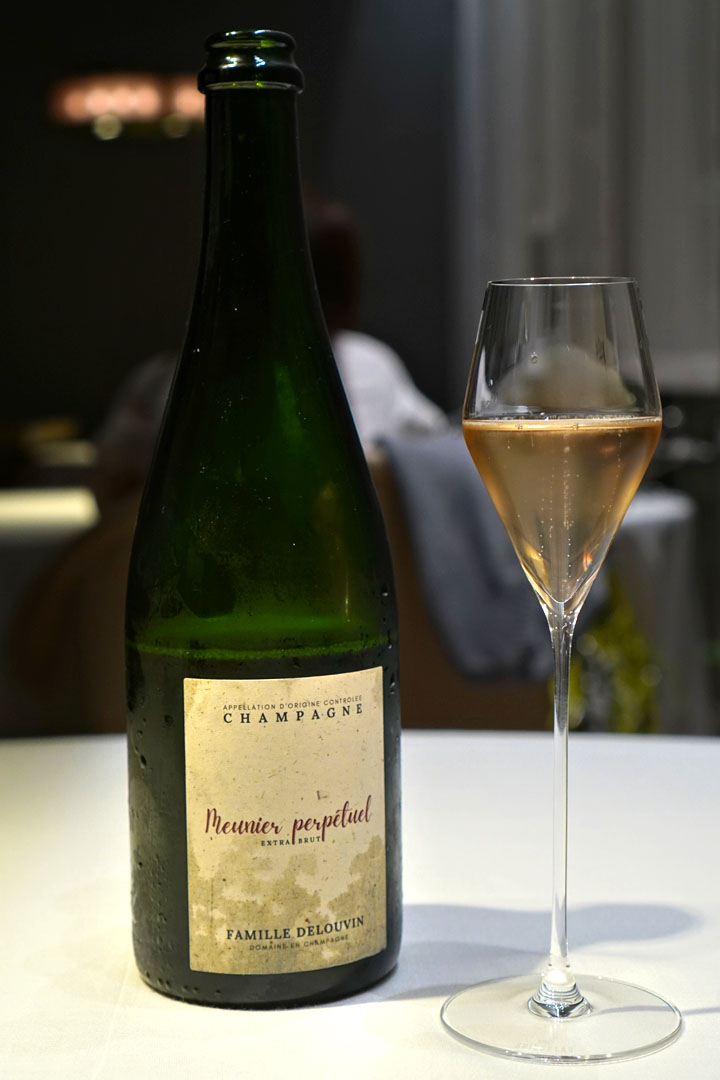
I was offered a complimentary pour of the Famille Delouvin 'Meunier Perpetuel' Extra Brut as a sort of welcome drink, which I obviously didn't turn down. The solera-style Champagne demonstrated fresh orchard fruits and traces of nuts on the nose. On the palate, think acidic and zippy, with a distinct floral quality to go along with more apple-y, nutty notes. Quite an apt apéritif.
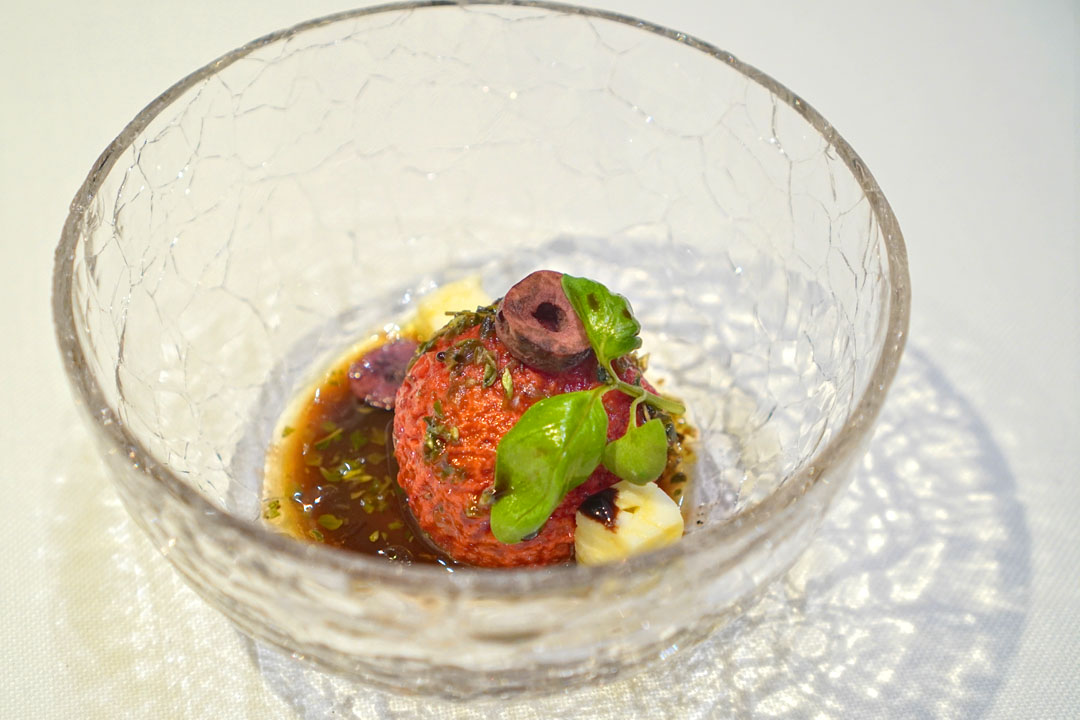
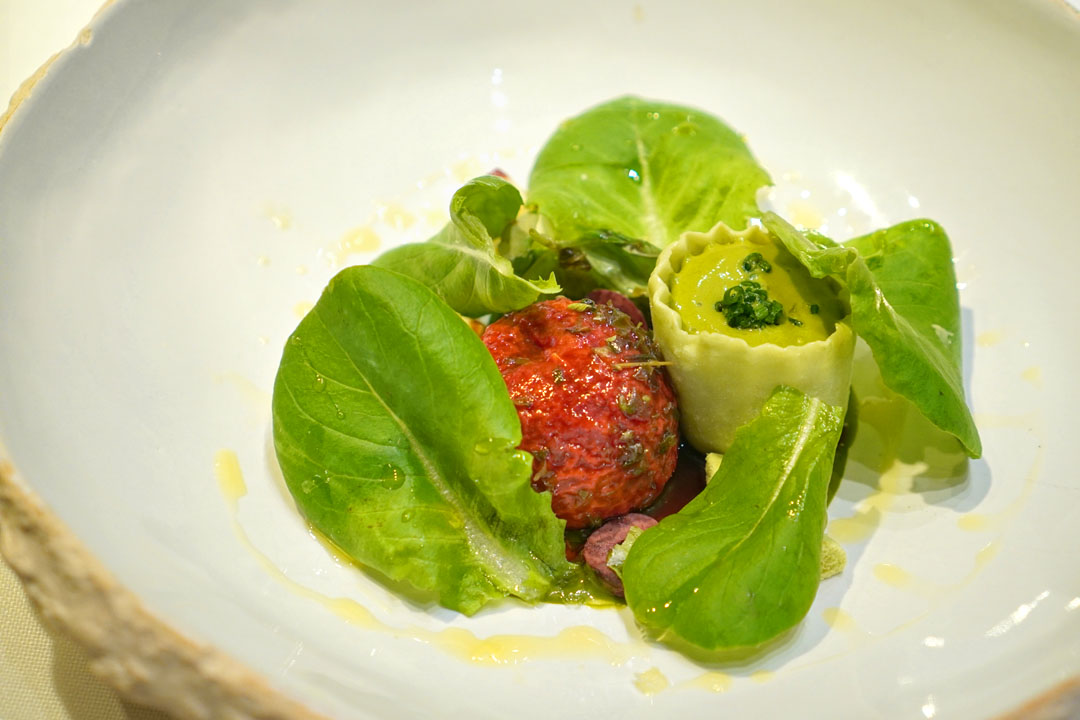
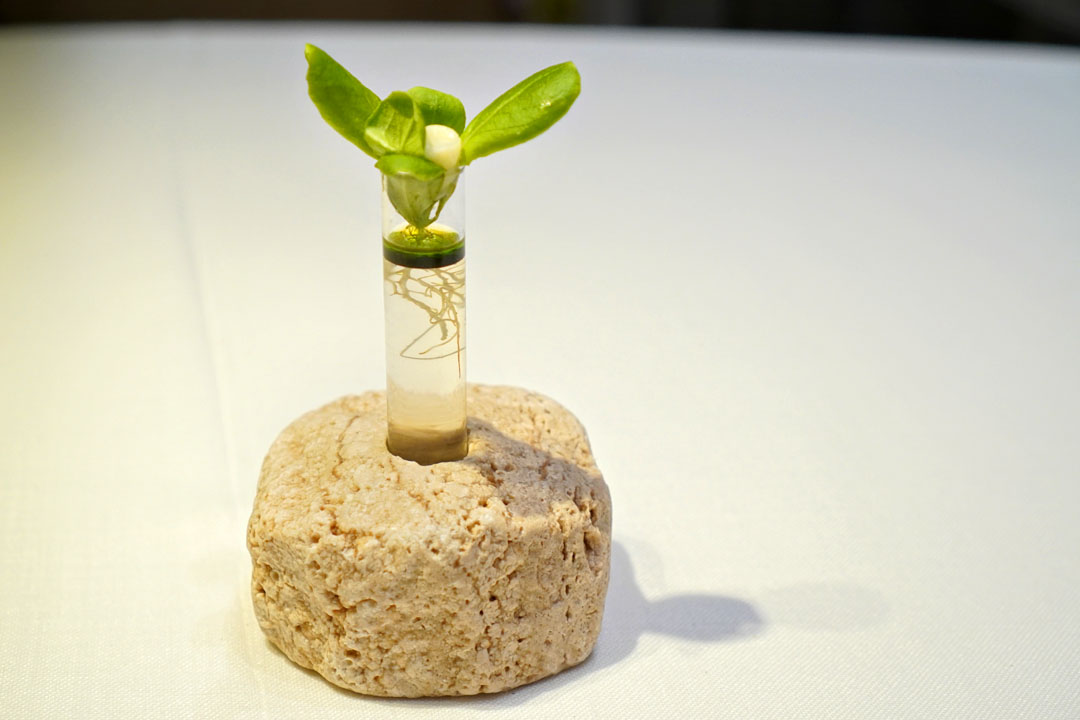
7: Mexican-style green salad and Greek-style preserved tomato with green tomato salad gazpacho and Caprese salad sprouts
In the first photo above, we see a bowl of semi-dried tomato coated with honey and soy, along with tomato tartare, black olive, and feta, which had actually been sitting at the table since the meal started. When it came time for this course, these contents were then combined with guacamole, freeze dried fruit, hydroponic baby leaves, and EVOO to make what's shown in the second photo. It was an effective marriage, with flavors tending to flit between the heavier tastes of the "Greek salad" and the brighter notes of the "Mexican salad." Next, I moved on to a refreshing gazpacho featuring tomato water and basil oil (forgot to take a picture, unfortunately), and ended with a Caprese salad in liquid form, which did a nice job conveying basil and a lingering cheesiness, though I didn't get much tomato.
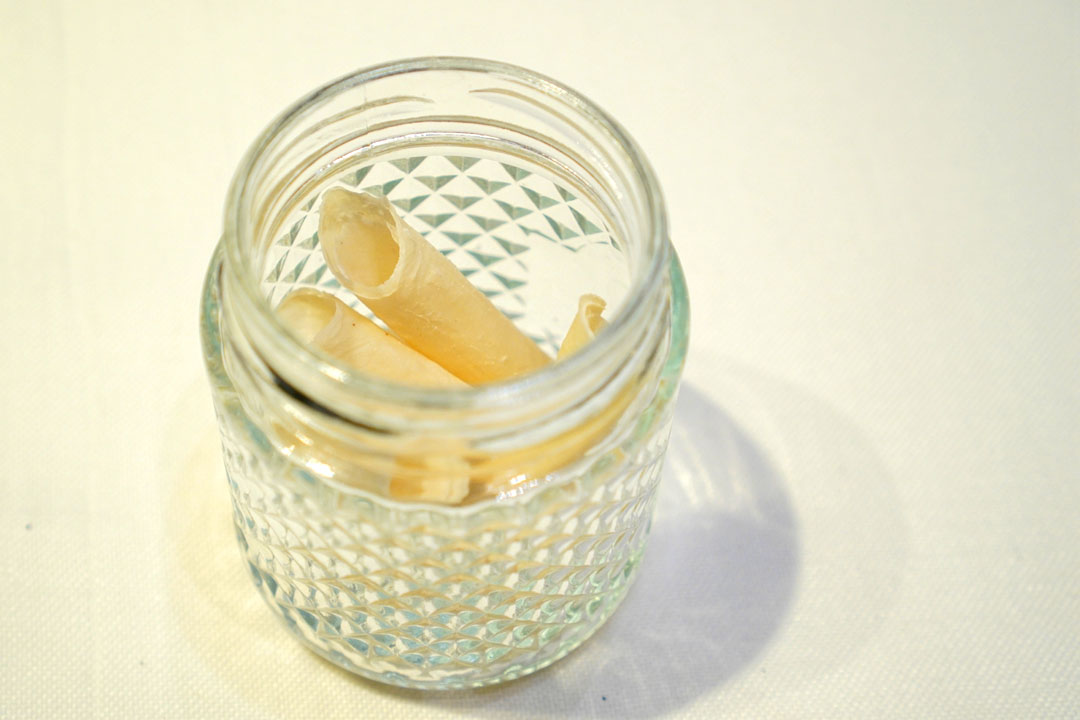
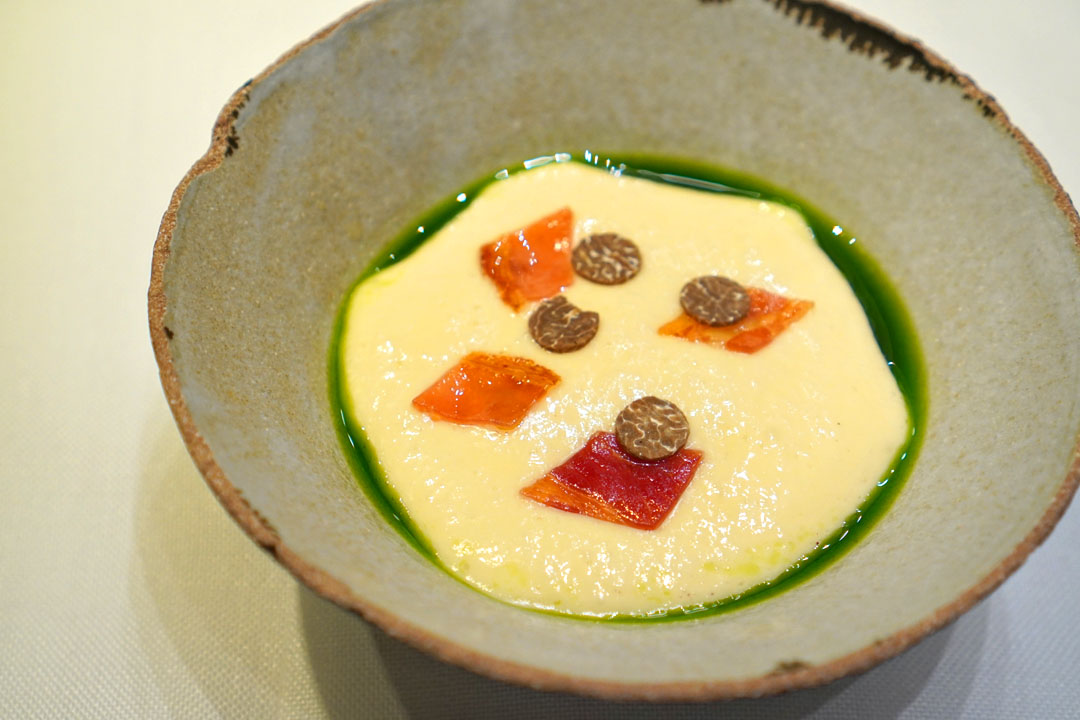
8: Dry maccheroni ai calamari with parmigiano e tartufo
Next was a thoroughly reimagined pasta course featuring shattery tubes of freeze-dried macaroni made from calamar, which tasted like the dried shredded squid of my childhood. Using tweezers, I was instructed to dip the maccheroni into an overtly cheesy Parmesan cream with ham and summer truffle. The overall effect was almost carbonara-esque, though not quite as cohesive as I was hoping for.

9: Anchovy Moulard Sirloin in a Gilda
A sliver of duck filet was meant to mimic an anchovy, and it did deliver in that regard taste-wise, really giving me that brininess you'd expect with the fish, while the bird wasn't too far off texturally, either. This impression was further heightened by the various accoutrements, which included both seaweed and sea grapes. Very cool.
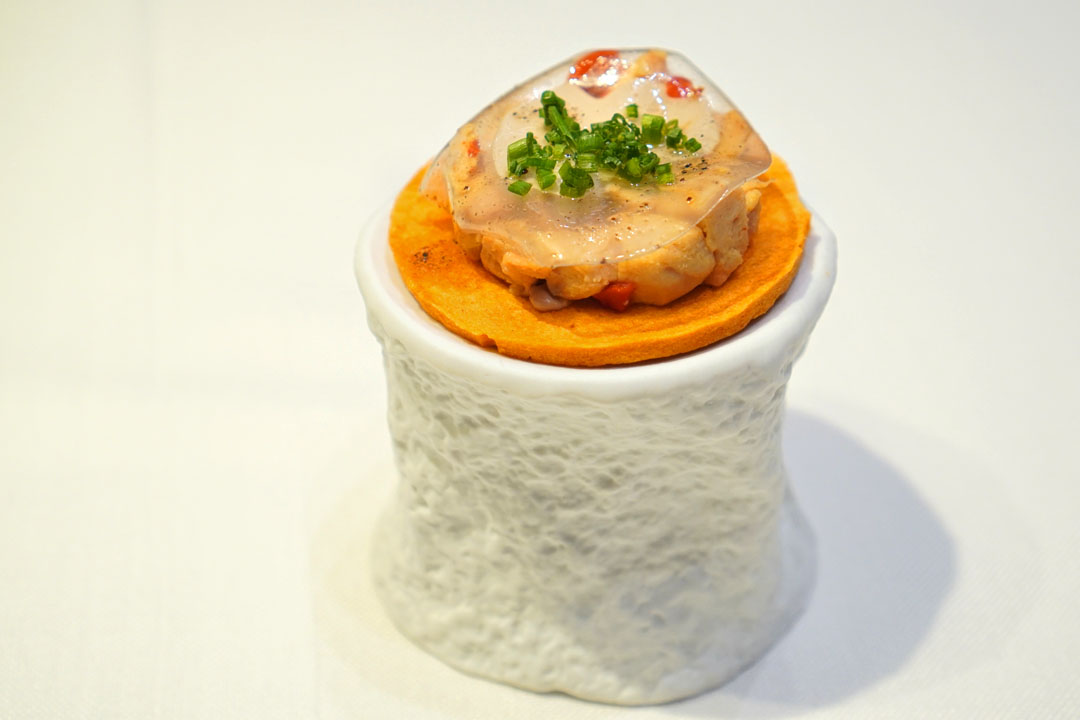
10: Foie Gras de l'Escala with escalivada bread and a veil of smoked oil
A crunchy escalibada-inspired cracker incorporated both onion and pepper, and actually reminded me of a BBQ-flavored potato chip, curiously enough. It combined swimmingly with the light, creamy foie, which was supported by what I believe was ancho ice cream, tomato gel, and soy-baba ghanoush dust.
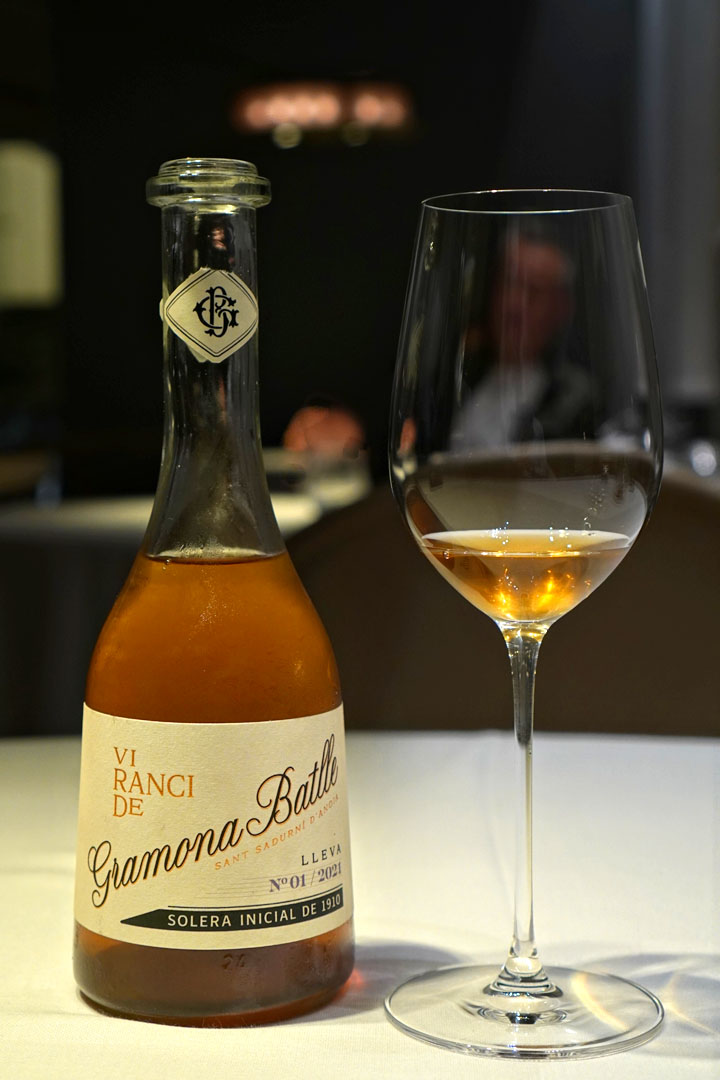
Given that I'd ordered a bottle of Gramona Corpinnat, I was graciously provided a complimentary pour of the Vi Ranci de Gramona Batlle, a rancio sec produced by the same winery. Made using the solera method, the wine was both super sugary and ultra nutty on the nose. Taking a sip, I found tart, acidic notes commingled with raisined fruit and more of those nutty, sherried, oxidative elements. I don't think I've had a wine of this style before, so I was glad that I got to try this.
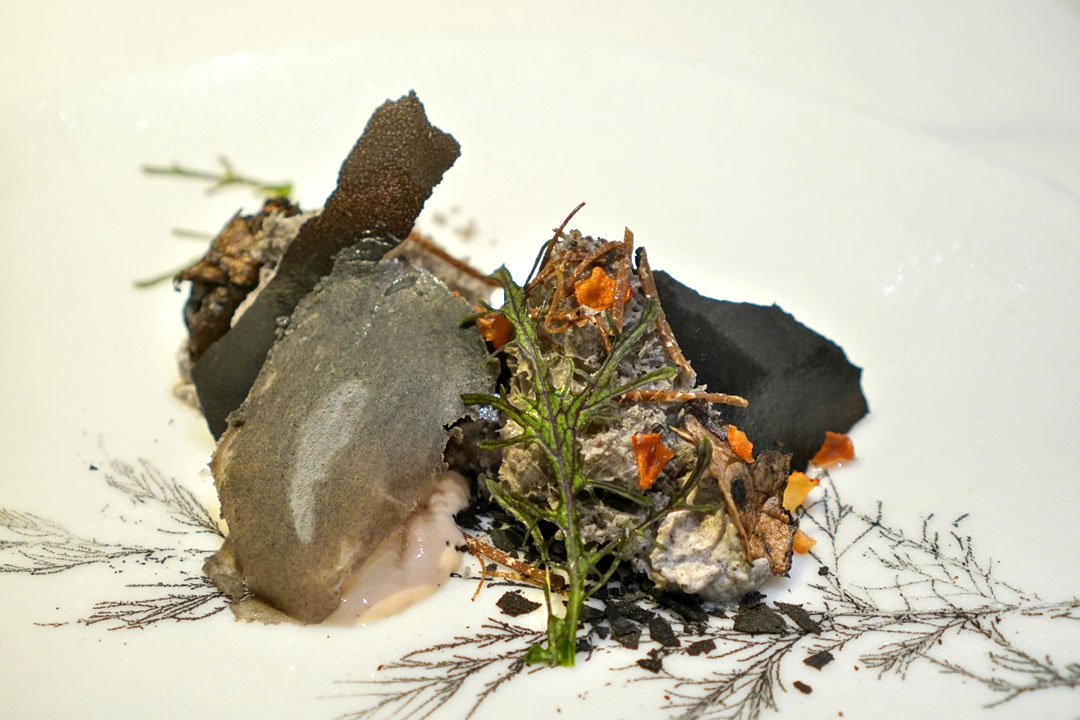
11: Scorched roots, seeds and bark, chervil ice-cream, smoked scamorza cheese and preserved truffles
Next was a visually interesting course that was meant to represent sprouts emerging from the forest floor after a fire. Things came together pretty well, and what caught my attention was the sweet-nuttiness of a black sesame butter, and how that interacted with the dish's plethora of earthy, smoky, and savory elements, the whole thing tied together by a chervil ice cream.
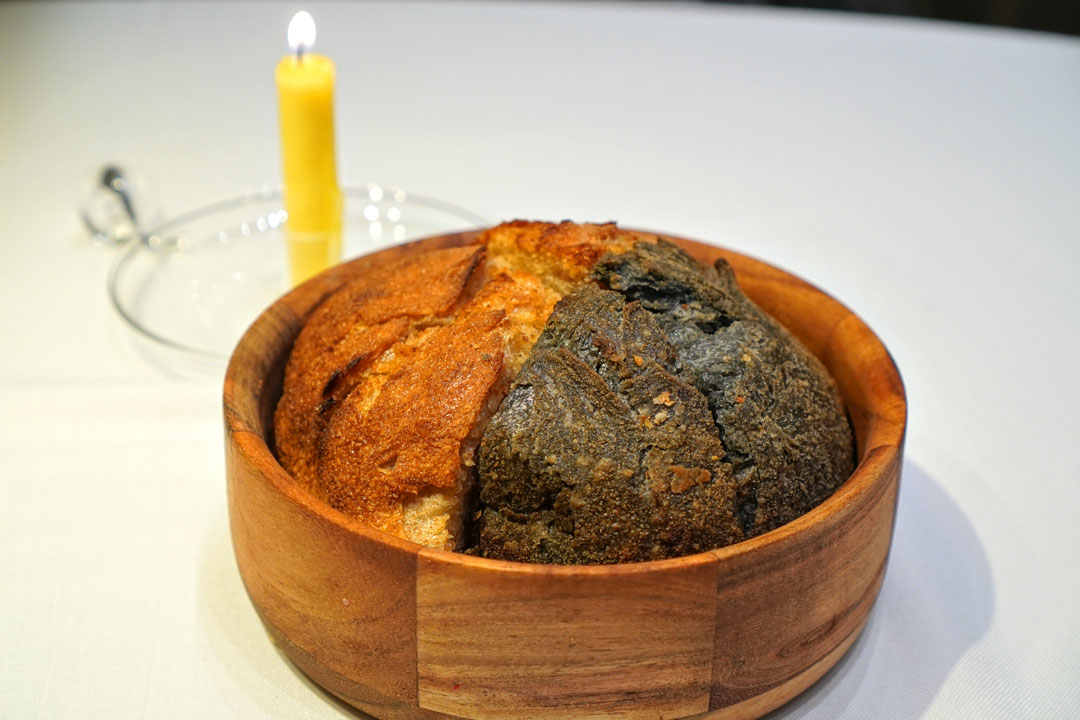
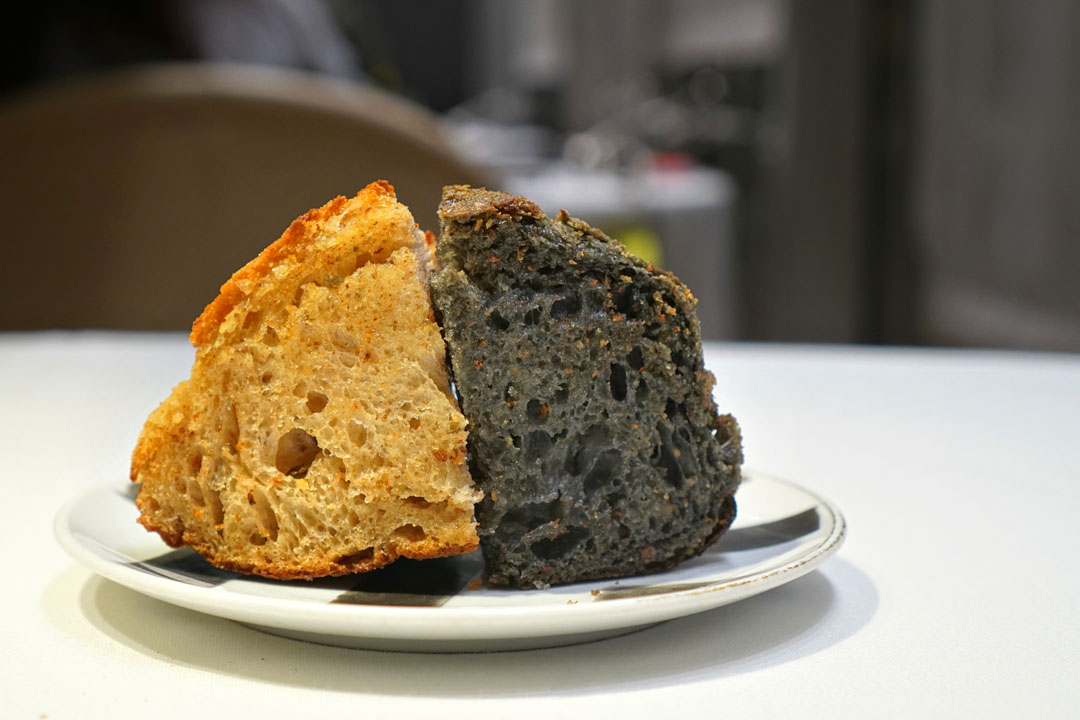
12: Flame grill on black bread
It was now time for bread service. An example incorporating activated charcoal was excellent, perhaps the best of this trip, thanks to its wonderful crustiness and pervasive, smoky tang. Meanwhile, the more traditional housemade bread was also commendable, with its spot-on interplay of crumb and crust. The breads were served with a candle made of an olive oil-y, smoky butter that was quite good; the problem was that it didn't melt nearly quickly enough.
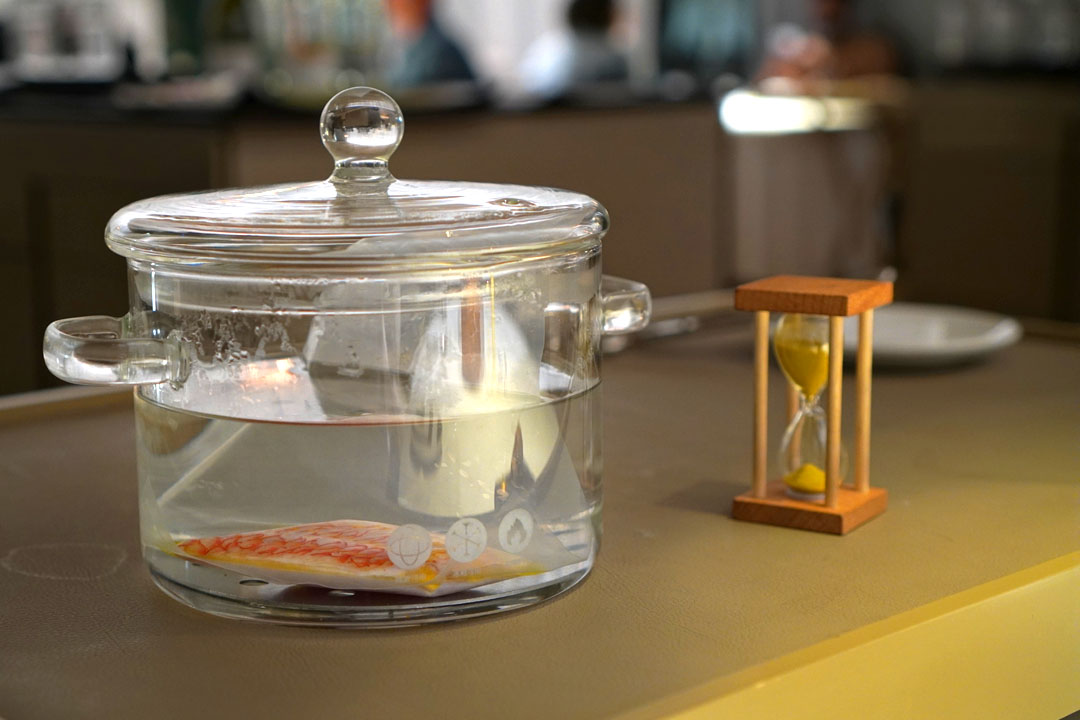
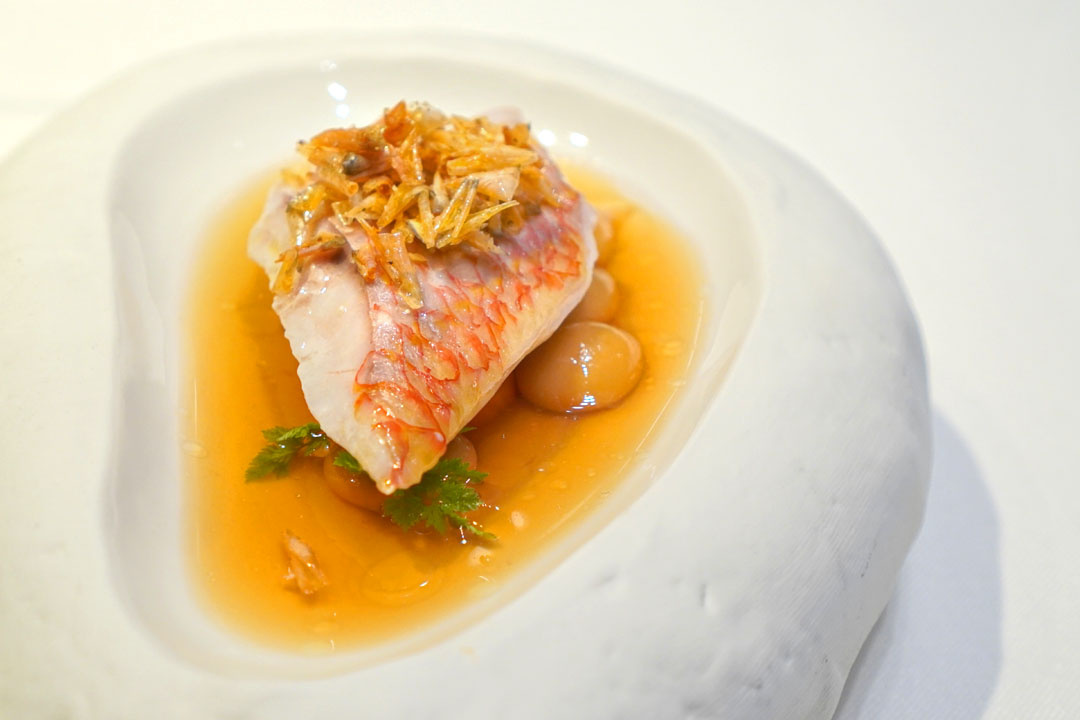
13: Red mullet with prawn Laksa and baked sweet potato
Striped red mullet was cooked sous vide tableside for five minutes (note the hourglass). The filet was superb texturally, and I loved how a topping of salty, crunchy scales lifted the dish. We also had a shrimp consommé to further bolster the flavors at play, and I liked the pricks of pungency from the lemongrass, too. My concern here was with the sweet potato, which veered overly sugary and tended to distract from the fish.
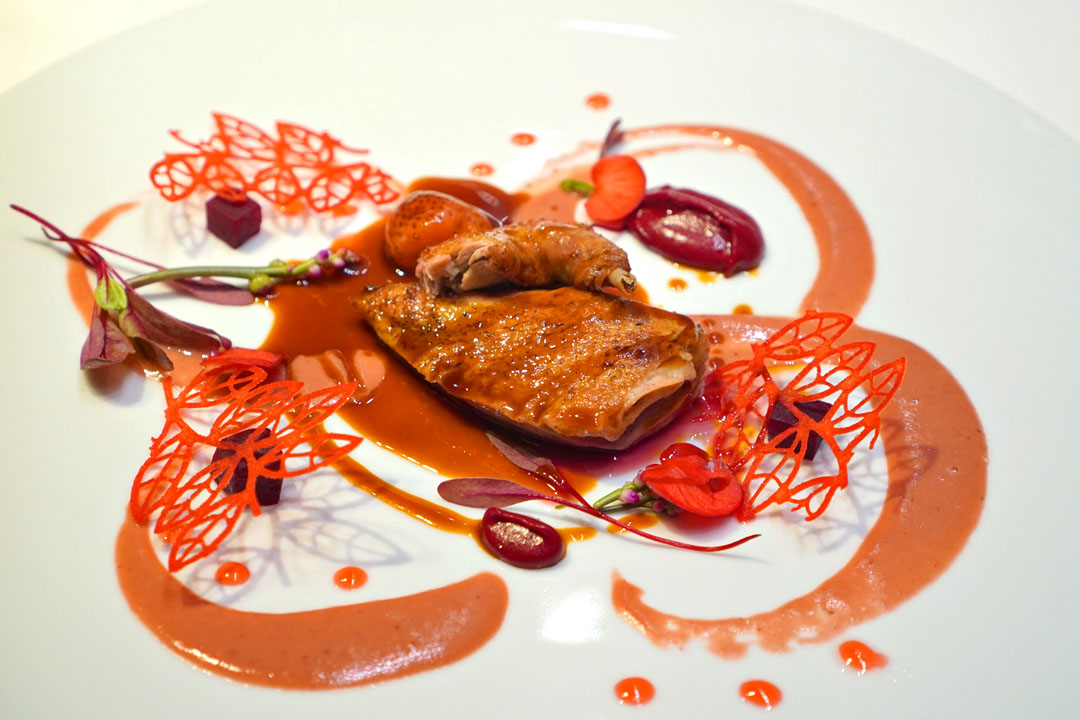
14: Miso-marinated pigeon with annatto and pink pepper, beetroot romesco, pickled strawberries with crispy kimchi and roses
In my final savory course, squab (smoked with rosemary and thyme I believe) arrived dense, juicy, and meaty, with the bird's breast being particularly earthy. The pigeon was quite tasty on its own, but I found that its various accompaniments didn't coalesce as well as I would've liked them to, and overall, things seemed a bit "flat."
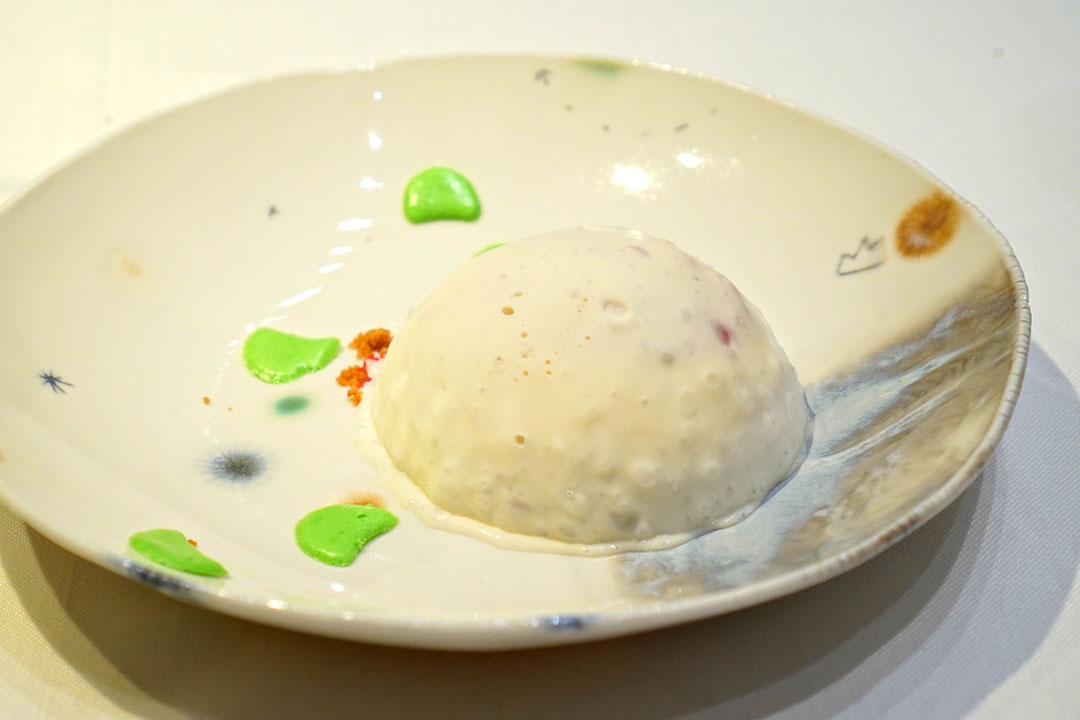
15: The Little Prince
It was now time for dessert, and this first one was inspired by Antoine de Saint-Exupéry's book Le Petit Prince (or El Principito in Spanish). What we had was a goat cheese cream, frozen tableside using liquid nitrogen and formed into a demisphere meant to resemble a planet. The chèvre ate luscious, lactic, and floral, and certainly made sense with its base of cookie crumbles. There were also textures of lime, raspberry, and "stardust" (edible glitter) sprayed on top for visual effect. Taken as a whole though, this did seem a tad disjointed.
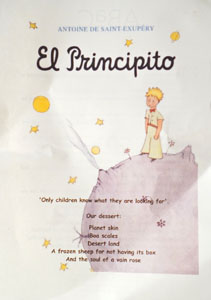
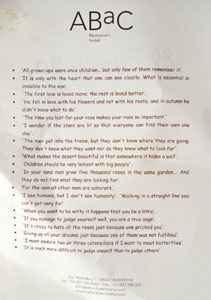
The course above even came with its own supplemental explainer. Click for larger versions.
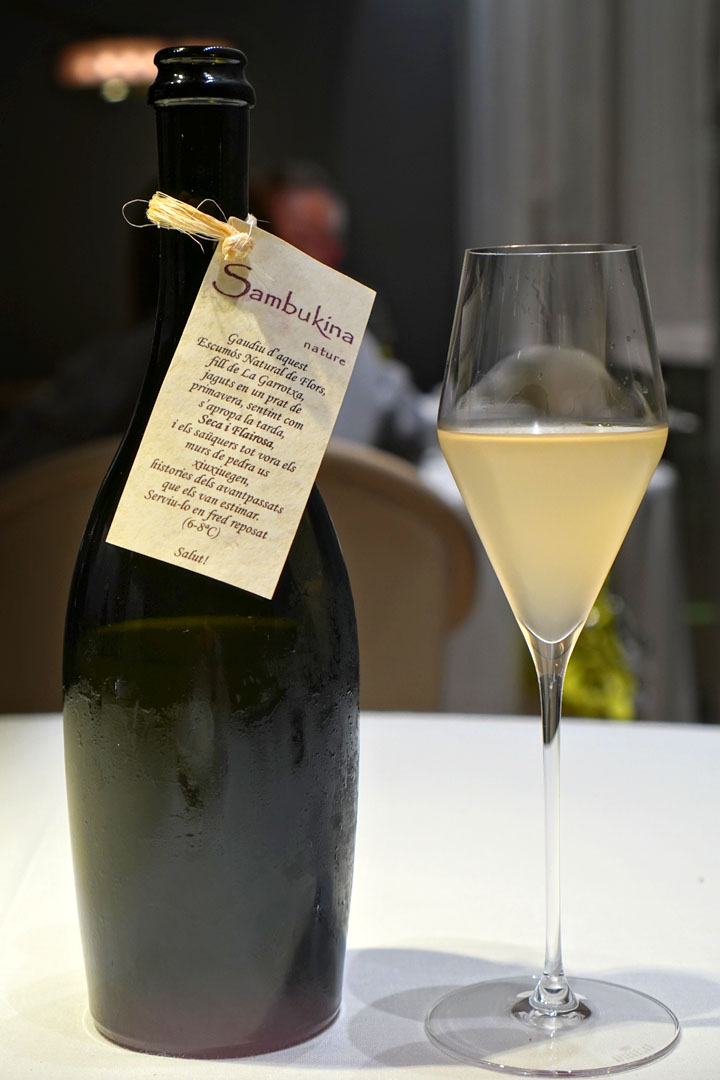
To pair with dessert, I had a pour of the Sambukina Nature [11€ ($11.98)], a sort of sparkling wine that I don't think I've tried before. Made using elderflower, the bouquet here was floral and citrusy, but with a "green" edge, while in terms of taste, think overtly fruity and quite quaffable, but again, with an herbaceous underpinning.

16: Aromas of crema catalana with Nitro/lio creamy popcorn, burned caramel ice cream and rice wafer
This rejiggered Catalan cream comprised a base of neula (Christmas biscuit) crumbles, burnt sugar ice cream, freeze dried textures of crema cremada, and kumquat skins. It did a pretty decent job communicating the qualities of the classic dessert, and showed off some welcomed touches of floral to go along with the dish's heftier, creamier notes. Nice array of textures, too.
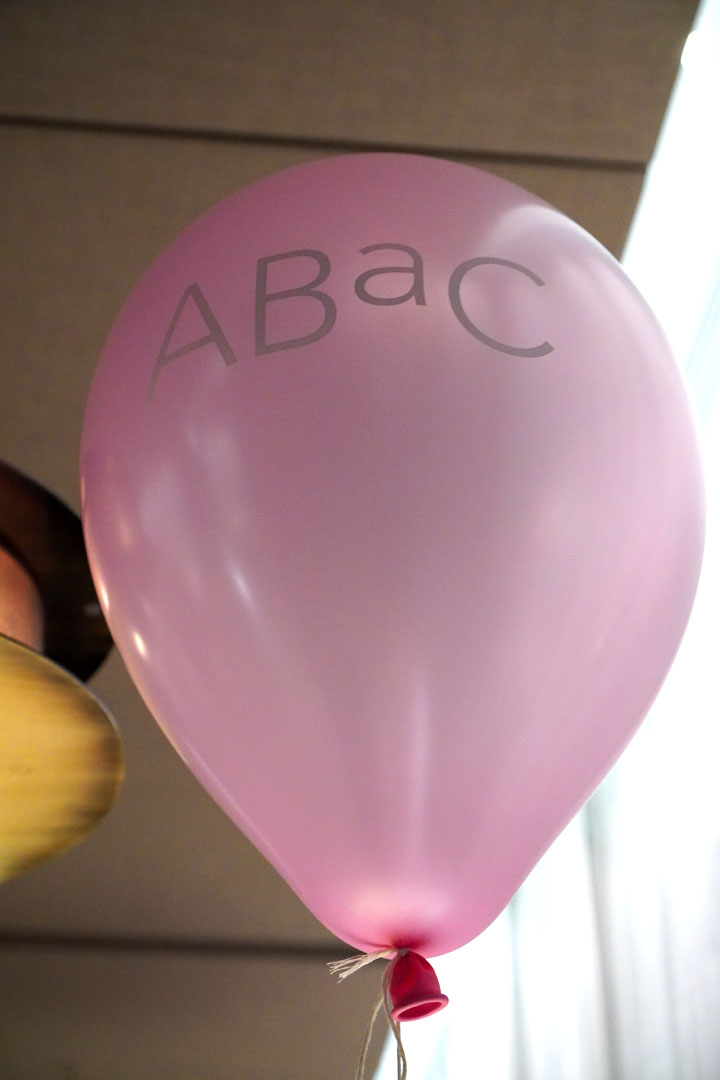
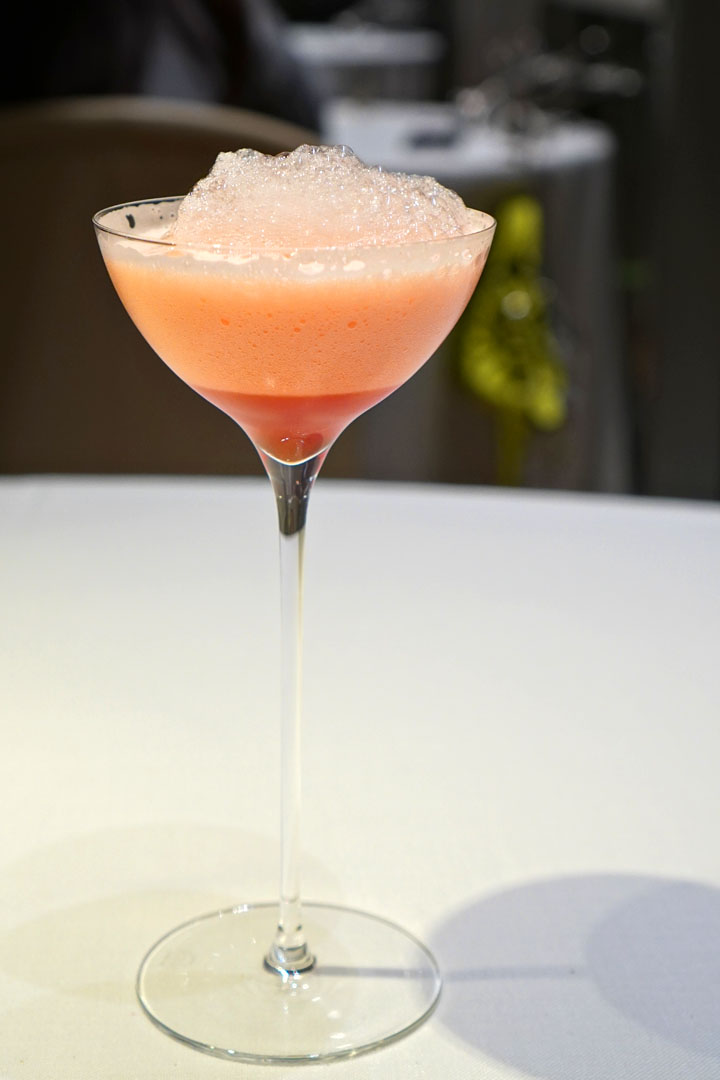
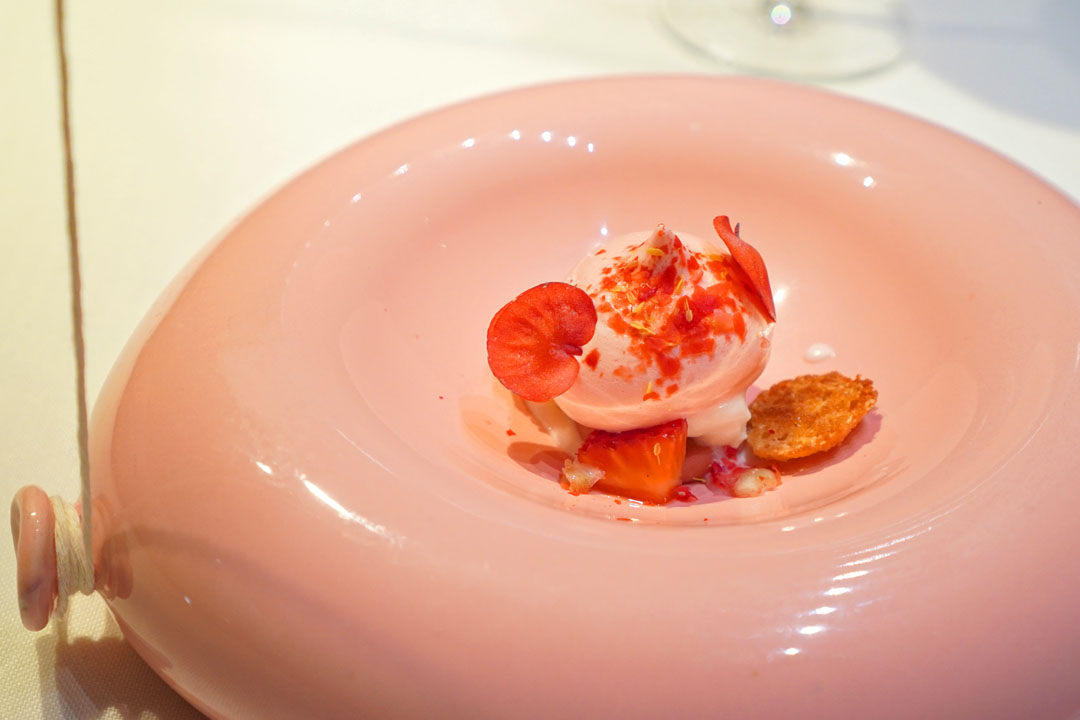
17: Balloon of strawberry and begonia lollies with strawberry and lavender water
This pink-hued dessert set a bevy of floral flavors against white chocolate and some grainy crumbles that I believe were salted almond. It was accompanied by a very strawberry-forward, perfume-y cocktail with an overarching herbiness, as well as a helium-filled balloon (in case I wanted to alter my voice).
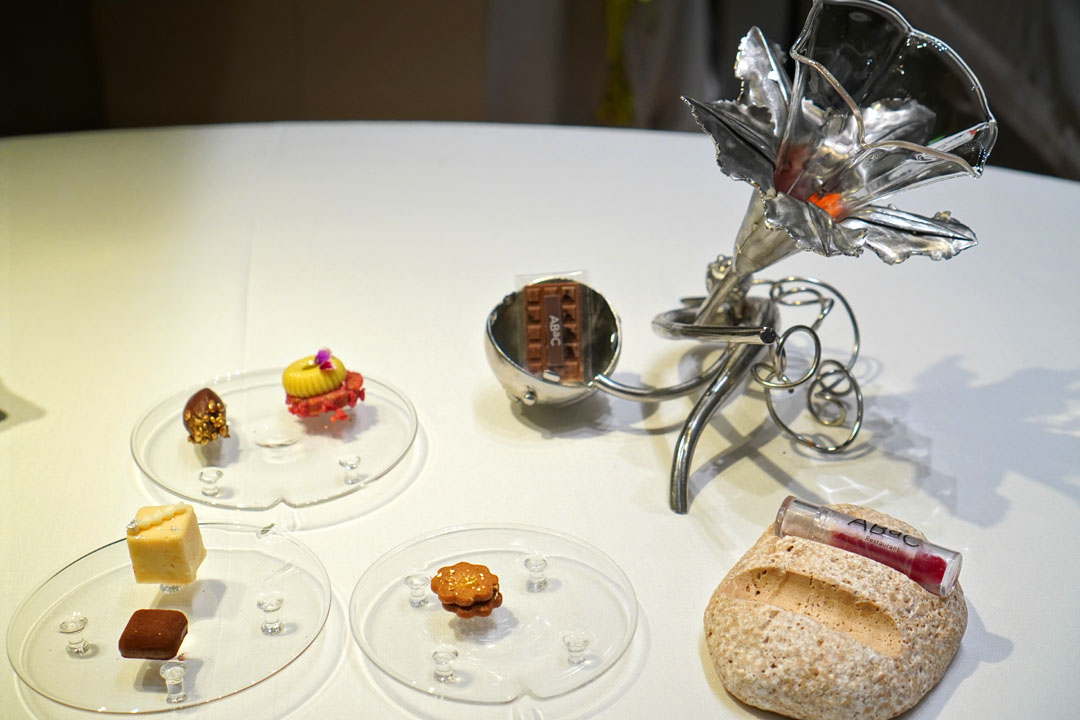
18: "Sweet Pumpkin"
And with that, it was now time for ABaC's assortment of mignardises: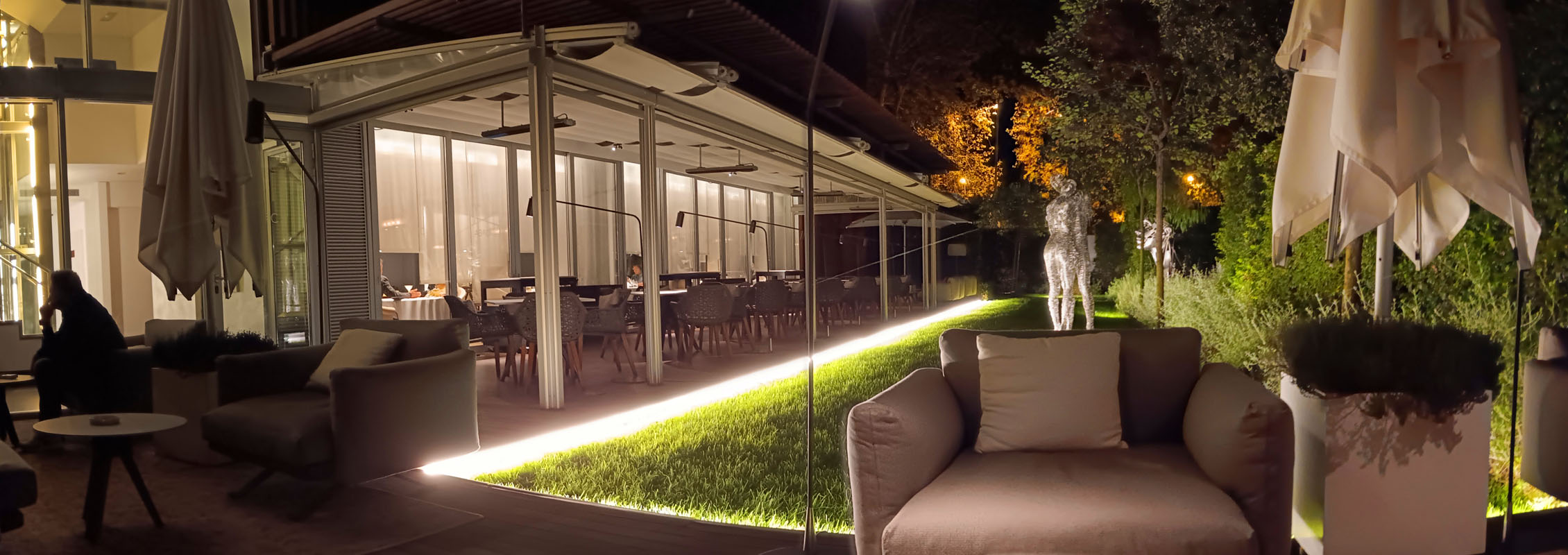
After my dinner, I retired into the garden for a moment to reflect on my experience. There was some creative, conceptual cuisine going on tonight, which resulted in some truly memorable dishes like nothing I'd ever encountered before. At the same time though, I found that certain techniques, certain preparations didn't land for me, so there could be a degree of editing, of polishing warranted in order to elevate the entire experience, as some of the cooking just seemed a bit "tentative."

Av. del Tibidabo, 1, Sarrià-Sant Gervasi, 08022 Barcelona, Spain
+34 933 19 66 00
www.abacrestaurant.com
Sun 10/20/2024, 08:00p-11:20p

After visiting both Sagrada Família and Park Güell in an admittedly Gaudí-heavy day, I ended up making my way to the Sant Gervasi – la Bonanova neighborhood for dinner at the ABaC Hotel, a boutique property on the edge of the city, near Tibidabo hill. Helmed by Chef Jordi Cruz, the hotel's namesake restaurant is one that I'd known about for years, so I definitely wanted to check it out and see how it'd hold up.
About the Chef: Jordi Cruz Mas was born in June 1978 in the city of Manresa, Bages county, north of Barcelona proper. He knew early on that he wanted to become a chef, and eventually made his way to the Escola Hoteleria Joviat in his hometown. At age 14, he began working as a server at Estany Clar in Cercs, and took over the kitchen at age 17, earning his first Michelin star there in November 2004. Cruz continued to make a name for himself through winning various culinary competitions, and would leave Estany Clar in December 2007.
From there, he became head chef at L'Angle at Hotel Món Sant Benet in Sant Fruitós de Bages, near Manresa, opening the restaurant in April 2008 and achieving a Michelin star just months later, in November that year. In April 2010, he took the reins at ABaC, which bowed in 2000 (on Carrer del Rec in Ciutat Vella--it moved to its current spot in May 2008) under the watch of Xavier Pellicer, most known for his work at Can Fabes. Cruz restored the restaurant's two Michelin star rating in December 2011, while a third star arrived in November 2017.
Following, the Chef continued to grow his relationship with the ABaC Group. In June 2012, he launched Ten's Tapas Restaurant at the Park Hotel, situated in the original home of ABaC, while April 2013 saw him debut as a judge on the Spanish version of MasterChef. Angle moved to Hotel Cram in June 2013, and received its second Michelin star in November 2019, though it's since been demoted back to one. In September 2019, Cruz opened the bistro-ish Atempo, which received its own star from Michelin in December 2020.

Here we see the dining room, a serene, elegant, somewhat muted space.

There's but a single tasting menu option at ABaC, priced at 295€ ($321.38) a head. The wine pairing costs an extra 140€ ($152.52), but as per usual, I opted for a bottle, and actually arrived early to pick out something from the restaurant's considerable wine list. Click for a larger version.

1: Bloody Mary on the rocks "Cocktail del seny i la rauxa"
The evening commenced with a welcome cocktail of sorts, one featuring clarified cherry tomato along with some sophisticated spicing, not to mention an ice cube composed of what I believe was beetroot and strawberry. It did a great job capturing the essence of the classic Bloody Mary, and was one of the best versions of the drink I've had.

2: Twirl of crouton sticks with creamy salad, caviar and cured tuna
Sitting atop a sweet-n-savory, shattery crouton was a base of ricotta-mascarpone cheese sauce, a lush tuna belly tartare, caviar, chives, and a slice of kumquat. Taken all together, it made for this vaguely Asian-y sensation that I didn't mind.

Not surprisingly, I chose something local and bubbly to drink, this time the Gramona Celler Batlle 2009 [169€ ($184.11)]. Initials aromas here were all about toffee and butterscotch, which led to flavors of both bright apple cider and darker, oxidized nuances. With some time, the sparkling wine went in a buttery, Burgundian direction on the nose, and further time brought a bouquet of sweet, juicy, tropical fruit, while the palate was still refreshing, vivacious, and citric this whole time. My final glass of the Corpinnat smelled somewhat earthier, and taste-wise, I found that the juice went in a more acidic, more bitter, boozier direction.


3: Brioche of grilled eel with lemongrass alioli
A Chinese-y French brioche was stuffed with tender, juicy grilled eel bathed in teriyaki sauce. Accompaniments included a lemongrass aioli, but I much preferred that freshly grated wasabi, which did an admirable job offsetting the sweetness of the bun.

Given the finger food nature of the bites above, a tightly-rolled moistened napkin was provided at this point.

4: Fire-grilled oyster with a smoked seafood velouté
In the final canapé course, an oyster was grilled in its own shell, then placed in a gilded shell and joined by squid velouté, olive oil, chives, and caviar. The key here was the back-and-forth between the bivalve's long-lingering brine and the creaminess of the sauce, with further accentuation from both the caviar and tangy olive oil.

5: Fire aerated "pincel" bread canapé-style with a bouillabaisse lio and caviar
Taking inspiration from the idea of "bread and butter," my next course turned out to be a twofer. Two servings of aerated bread were presented, and I began with the one on the right, with its Breton butter base, freeze-dried mussel, and freeze-dried red prawn. The bite succinctly conveyed the character of a seafood stew, but I wasn't as keen on its super dry texture. I preferred my second bite, which combined caviar and French butter in expert fashion, with both elements nicely offset by the crunch of the "pincel." Also tucked into a napkin here was a delightfully thin bread meant to pair with the dish below.

6: Cured sea bream and molluscs and "gazpachuelo" of spring onions with cilantro
This reimagined ceviche was a definite favorite of mine, really representing the spirit of the traditional dish. It was composed of clams, goose barnacles, mussels, cured seaweed, coriander oil, golden lattice bread, and chickpea hummus ice cream, all set in a zingy lime-onion marinade poured tableside. I loved the brightness and acidity present, and how that meshed with the assertive brine and textures of the seafood (the mussels in particular), all while the ice cream proffered a wonderful temperature contrast.

I was offered a complimentary pour of the Famille Delouvin 'Meunier Perpetuel' Extra Brut as a sort of welcome drink, which I obviously didn't turn down. The solera-style Champagne demonstrated fresh orchard fruits and traces of nuts on the nose. On the palate, think acidic and zippy, with a distinct floral quality to go along with more apple-y, nutty notes. Quite an apt apéritif.



7: Mexican-style green salad and Greek-style preserved tomato with green tomato salad gazpacho and Caprese salad sprouts
In the first photo above, we see a bowl of semi-dried tomato coated with honey and soy, along with tomato tartare, black olive, and feta, which had actually been sitting at the table since the meal started. When it came time for this course, these contents were then combined with guacamole, freeze dried fruit, hydroponic baby leaves, and EVOO to make what's shown in the second photo. It was an effective marriage, with flavors tending to flit between the heavier tastes of the "Greek salad" and the brighter notes of the "Mexican salad." Next, I moved on to a refreshing gazpacho featuring tomato water and basil oil (forgot to take a picture, unfortunately), and ended with a Caprese salad in liquid form, which did a nice job conveying basil and a lingering cheesiness, though I didn't get much tomato.


8: Dry maccheroni ai calamari with parmigiano e tartufo
Next was a thoroughly reimagined pasta course featuring shattery tubes of freeze-dried macaroni made from calamar, which tasted like the dried shredded squid of my childhood. Using tweezers, I was instructed to dip the maccheroni into an overtly cheesy Parmesan cream with ham and summer truffle. The overall effect was almost carbonara-esque, though not quite as cohesive as I was hoping for.

9: Anchovy Moulard Sirloin in a Gilda
A sliver of duck filet was meant to mimic an anchovy, and it did deliver in that regard taste-wise, really giving me that brininess you'd expect with the fish, while the bird wasn't too far off texturally, either. This impression was further heightened by the various accoutrements, which included both seaweed and sea grapes. Very cool.

10: Foie Gras de l'Escala with escalivada bread and a veil of smoked oil
A crunchy escalibada-inspired cracker incorporated both onion and pepper, and actually reminded me of a BBQ-flavored potato chip, curiously enough. It combined swimmingly with the light, creamy foie, which was supported by what I believe was ancho ice cream, tomato gel, and soy-baba ghanoush dust.

Given that I'd ordered a bottle of Gramona Corpinnat, I was graciously provided a complimentary pour of the Vi Ranci de Gramona Batlle, a rancio sec produced by the same winery. Made using the solera method, the wine was both super sugary and ultra nutty on the nose. Taking a sip, I found tart, acidic notes commingled with raisined fruit and more of those nutty, sherried, oxidative elements. I don't think I've had a wine of this style before, so I was glad that I got to try this.

11: Scorched roots, seeds and bark, chervil ice-cream, smoked scamorza cheese and preserved truffles
Next was a visually interesting course that was meant to represent sprouts emerging from the forest floor after a fire. Things came together pretty well, and what caught my attention was the sweet-nuttiness of a black sesame butter, and how that interacted with the dish's plethora of earthy, smoky, and savory elements, the whole thing tied together by a chervil ice cream.


12: Flame grill on black bread
It was now time for bread service. An example incorporating activated charcoal was excellent, perhaps the best of this trip, thanks to its wonderful crustiness and pervasive, smoky tang. Meanwhile, the more traditional housemade bread was also commendable, with its spot-on interplay of crumb and crust. The breads were served with a candle made of an olive oil-y, smoky butter that was quite good; the problem was that it didn't melt nearly quickly enough.


13: Red mullet with prawn Laksa and baked sweet potato
Striped red mullet was cooked sous vide tableside for five minutes (note the hourglass). The filet was superb texturally, and I loved how a topping of salty, crunchy scales lifted the dish. We also had a shrimp consommé to further bolster the flavors at play, and I liked the pricks of pungency from the lemongrass, too. My concern here was with the sweet potato, which veered overly sugary and tended to distract from the fish.

14: Miso-marinated pigeon with annatto and pink pepper, beetroot romesco, pickled strawberries with crispy kimchi and roses
In my final savory course, squab (smoked with rosemary and thyme I believe) arrived dense, juicy, and meaty, with the bird's breast being particularly earthy. The pigeon was quite tasty on its own, but I found that its various accompaniments didn't coalesce as well as I would've liked them to, and overall, things seemed a bit "flat."

15: The Little Prince
It was now time for dessert, and this first one was inspired by Antoine de Saint-Exupéry's book Le Petit Prince (or El Principito in Spanish). What we had was a goat cheese cream, frozen tableside using liquid nitrogen and formed into a demisphere meant to resemble a planet. The chèvre ate luscious, lactic, and floral, and certainly made sense with its base of cookie crumbles. There were also textures of lime, raspberry, and "stardust" (edible glitter) sprayed on top for visual effect. Taken as a whole though, this did seem a tad disjointed.


The course above even came with its own supplemental explainer. Click for larger versions.

To pair with dessert, I had a pour of the Sambukina Nature [11€ ($11.98)], a sort of sparkling wine that I don't think I've tried before. Made using elderflower, the bouquet here was floral and citrusy, but with a "green" edge, while in terms of taste, think overtly fruity and quite quaffable, but again, with an herbaceous underpinning.

16: Aromas of crema catalana with Nitro/lio creamy popcorn, burned caramel ice cream and rice wafer
This rejiggered Catalan cream comprised a base of neula (Christmas biscuit) crumbles, burnt sugar ice cream, freeze dried textures of crema cremada, and kumquat skins. It did a pretty decent job communicating the qualities of the classic dessert, and showed off some welcomed touches of floral to go along with the dish's heftier, creamier notes. Nice array of textures, too.



17: Balloon of strawberry and begonia lollies with strawberry and lavender water
This pink-hued dessert set a bevy of floral flavors against white chocolate and some grainy crumbles that I believe were salted almond. It was accompanied by a very strawberry-forward, perfume-y cocktail with an overarching herbiness, as well as a helium-filled balloon (in case I wanted to alter my voice).

18: "Sweet Pumpkin"
And with that, it was now time for ABaC's assortment of mignardises:
- As instructed, I began with a frozen, floral, fruity "lipstick" made from rose and strawberry.
- I was then told to have the strawberry-amaretto (placed in the pumpkin flower), which somewhat mimicked the cocktail above I'd just consumed.
- A raspberry-pistachio bonbon definitely exhibited the salty, savory qualities of the nut.
- Next to it was dark chocolate paired with the rich flavors of a coffee liqueur.
- The cinnamon cookie displayed the sweet spice I was expecting, but with a savory tinge.
- The chocolate bar, meanwhile, was also coffee-flavored, but went in a much smokier, stickier direction.
- The hazelnut and cocoa bonbon on the bottom-left was great texturally with its smooth-yet-crunchy consistency, and also demonstrated this creeping nutty-sweetness.
- Last up was a chèvre cheesecake with a gratifyingly lactic funk. Given its stronger taste, I was told to eat this last--good advice.

After my dinner, I retired into the garden for a moment to reflect on my experience. There was some creative, conceptual cuisine going on tonight, which resulted in some truly memorable dishes like nothing I'd ever encountered before. At the same time though, I found that certain techniques, certain preparations didn't land for me, so there could be a degree of editing, of polishing warranted in order to elevate the entire experience, as some of the cooking just seemed a bit "tentative."

2 Comments:
Kevin: I know there aren't as many comments as there used to be in years gone by, but I hope you don't quit this blog. It is pure joy getting to read and see all the things you try both in California and around the world!
Ah thanks--good to hear that you've been enjoying this site over the years! I feel that people don't have the attention spans to actually read long-format blogs these days, so the lower level of engagement is hardly surprising.
Post a Comment
Subscribe to Post Comments [Atom]
<< Home